brake CHEVROLET ASTRO CARGO VAN 1995 2.G User Guide
[x] Cancel search | Manufacturer: CHEVROLET, Model Year: 1995, Model line: ASTRO CARGO VAN, Model: CHEVROLET ASTRO CARGO VAN 1995 2.GPages: 342, PDF Size: 17.57 MB
Page 91 of 342
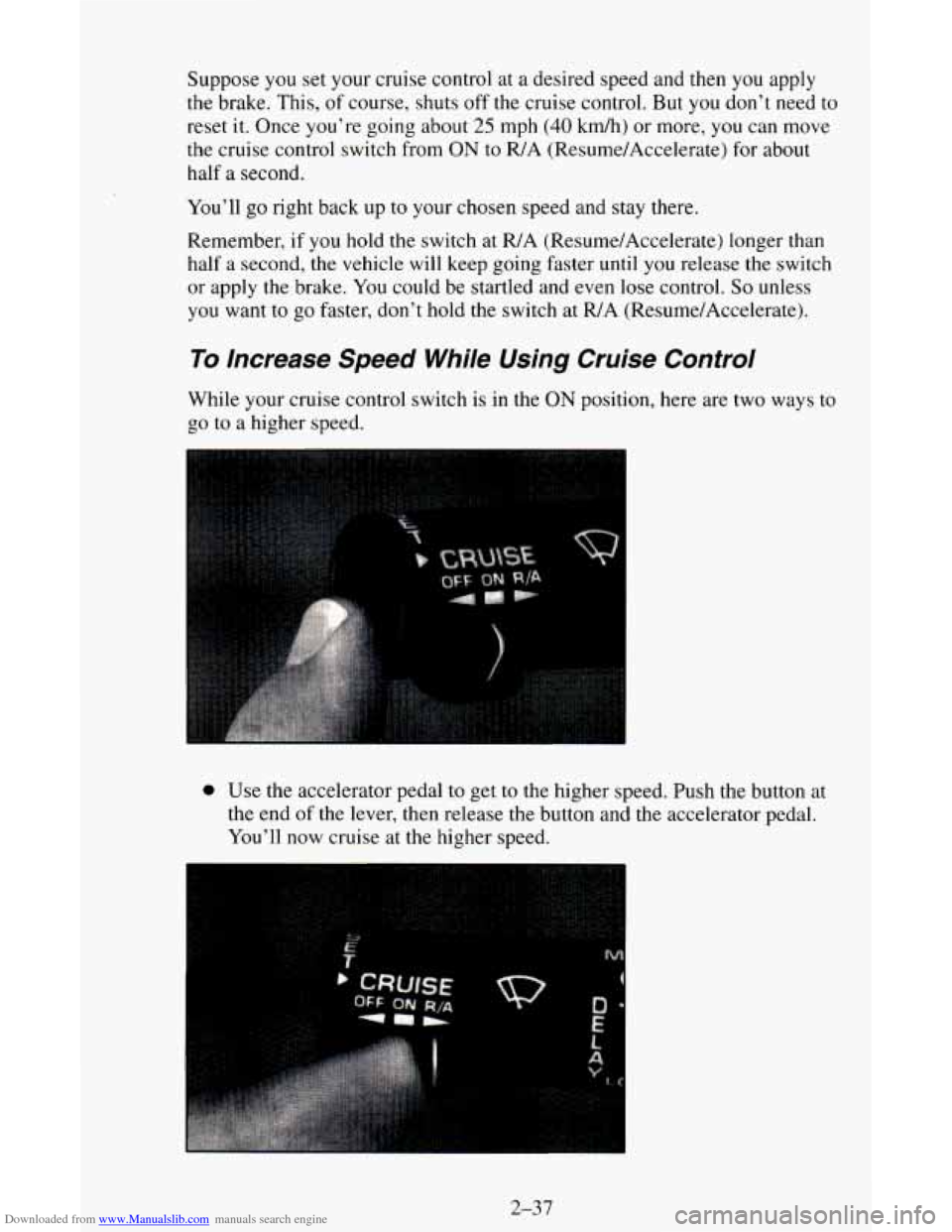
Downloaded from www.Manualslib.com manuals search engine Suppose you set your cruise control at a desired speed and then you apply
the brake. This,
of course, shuts off the cruise control. But you don’t need to
reset it. Once you’re going about
25 mph (40 kdh) or more, you can move
the cruise control switch from
ON to R/A (Resume/Accelerate) for about
half
a second.
You’ll go right back up to your chosen speed and stay there.
Remember, if you hold the switch at R/A (Resume/Accelerate) longer than
half a second, the vehicle will keep going faster
until you release the switch
or apply the brake. You could be startled and even lose control.
So unless
you want to
go faster, don’t hold the switch at R/A (Resume/Accelerate).
To lncrease Speed While Using Cruise Control
While your cruise control switch is in the ON position, here are two ways to
go
to a higher speed.
0 Use the accelerator pedal to get to the higher speed. Push the button at
the end
of the lever, then release the button and the accelerator pedal.
You’ll now cruise at the higher speed.
2-37
Page 92 of 342
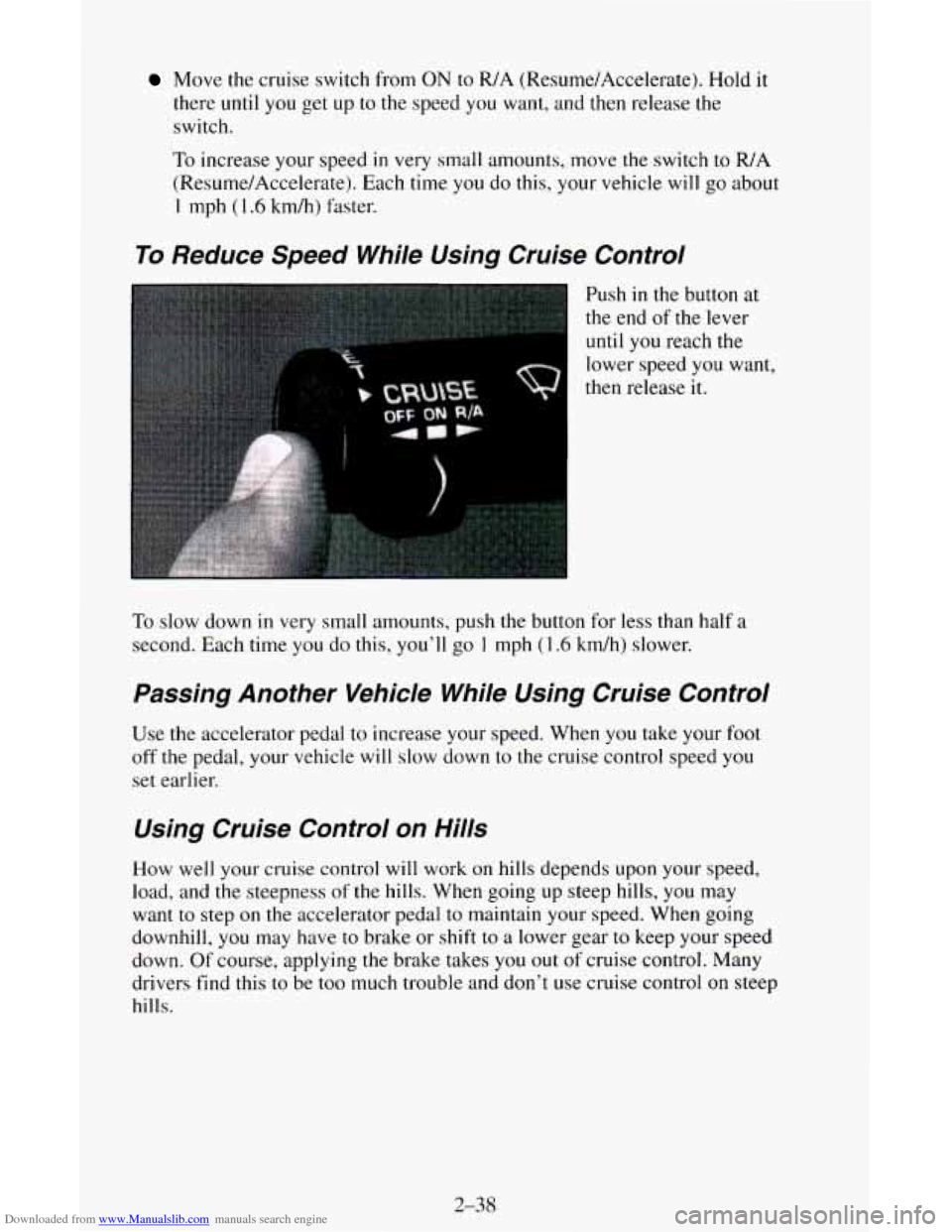
Downloaded from www.Manualslib.com manuals search engine Move the cruise switch from ON to WA (Resume/Accelerate). Hold it
there until
you get up to the speed you want, and then release the
switch.
To increase your speed in very small amounts, move the switch to R/A
(Resume/Accelerate). Each time you
do this, your vehicle will go about
1 mph (1.6 km/h) faster.
To Reduce Speed While Using Cruise Control
4
Push in the button at
the end of the lever
until you reach the
lower speed you want,
then release it.
To slow down in very small amounts, push the button for less than half a
second. Each time you do this, you’ll go 1 mph (1.6 km/h) slower.
Passing Another Vehicle While Using Cruise Control
Use the accelerator pedal to increase your speed. When you take your foot
off
the pedal, your vehicle will slow down to the cruise control speed you
set earlier.
Using Cruise Control on Hills
How well your cruise control will work on hills depends upon your speed,
load, and the steepness
of the hills. When going up steep hills, you may
want
to step on the accelerator pedal to maintain your speed. When going
downhill, you may have to brake or shift to
a lower gear to keep your speed
down. Of course, applying
the brake takes you out of cruise control. Many
drivers find this to be too much trouble and don’t use cruise control
on steep
hills.
2-38
Page 93 of 342
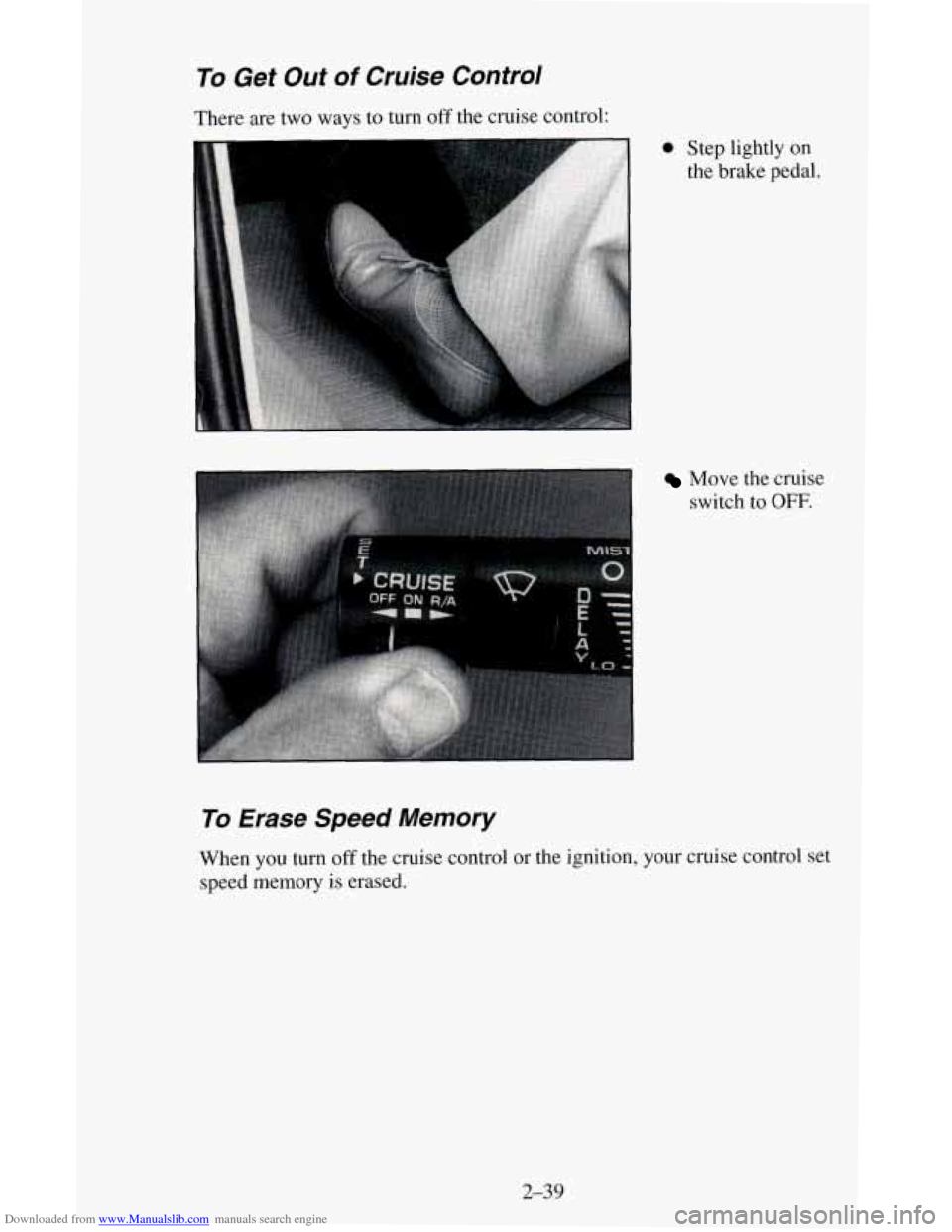
Downloaded from www.Manualslib.com manuals search engine To Get Out of Cruise Control
There are two ways to turn off the cruise control:
0 Step lightly on
the brake pedal.
Move the cruise
switch to
OFF.
To Erase Speed Memory
When you turn off the cruise control or the ignition, your cruise control set
speed memory is erased.
2-39
Page 95 of 342
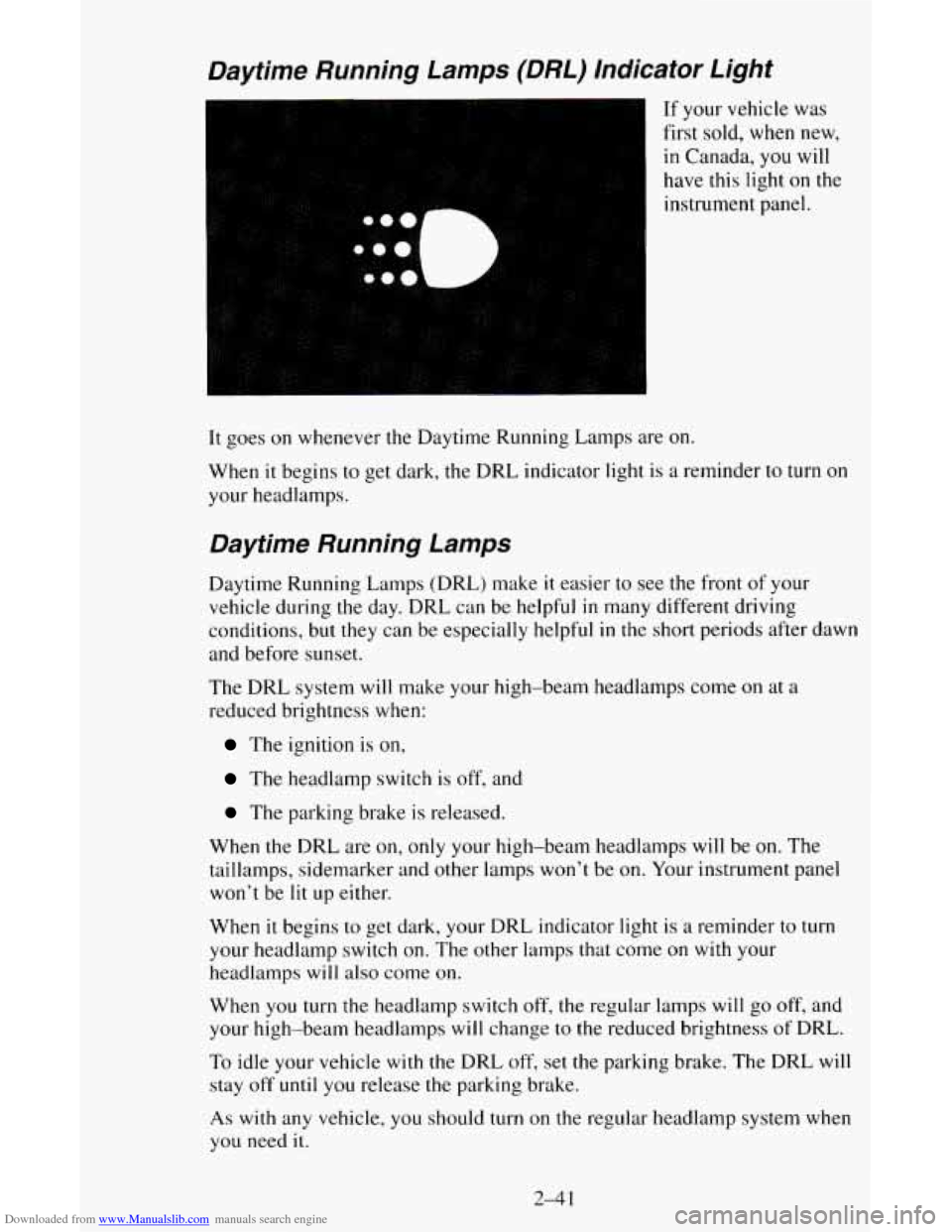
Downloaded from www.Manualslib.com manuals search engine Daytime Running Lamps (DRL) Indicator Light
If your vehicle was
first sold, when new,
in Canada,
you will
have this light on the
instrument panel.
It goes on whenever the Daytime Running Lamps are on.
When it begins to get dark, the DRL indicator light is a reminder to turn on
your headlamps.
Daytime Running Lamps
Daytime Running Lamps (DRL) make it easier to see the front of your
vehicle during the day. DRL can be helpful
in many different driving
conditions, but
they can be especially helpful in the short periods after dawn
and before sunset.
The DRL system will make your high-beam headlamps come
on at a
reduced brightness when:
The ignition is on,
The headlamp switch is off, and
The parking brake is released.
When the DRL are on, only your high-beam headlamps will be
on. The
taillamps, sidemarker and other lamps
won’t be on. Your instrument panel
won’t be
lit up either.
When it begins to get dark, your DRL indicator light is
a reminder to turn
your headlamp switch on. The other lamps that come on with your
headlamps will also come
on.
When you turn the headlamp switch off, the regular lamps will go off, and
your high-beam headlamps
will change to the reduced brightness of DRL.
To idle your vehicle with the DRL off, set the parking brake. The DRL will
stay
off until you release the parking brake.
As with any vehicle, you should turn on the regular headlamp system when
you need it.
2-4 1
Page 103 of 342
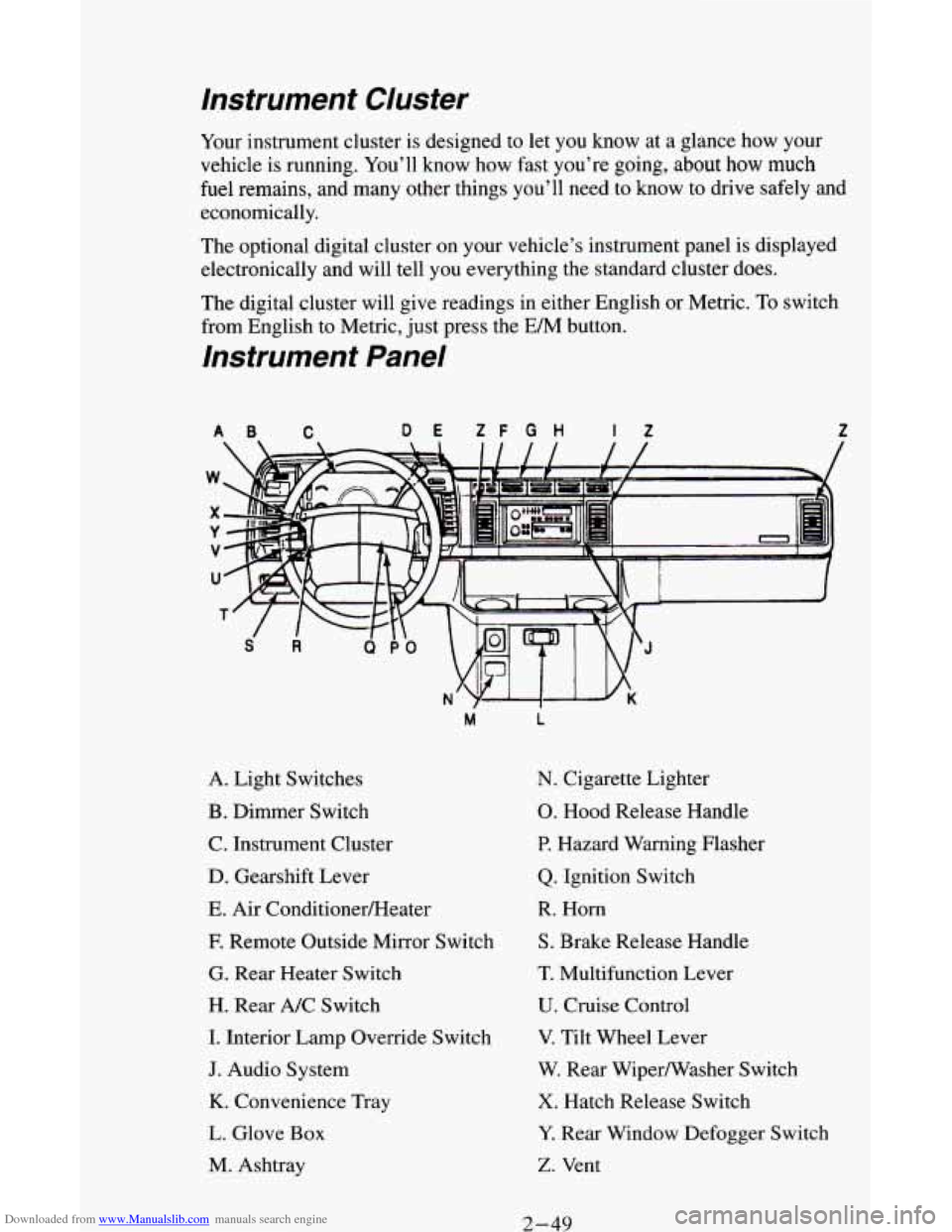
Downloaded from www.Manualslib.com manuals search engine Instrument Cluster
Your instrument cluster is designed to let you know at a glance how your
vehicle is running. You’ll know how fast you’re going, about
how much
fuel remains, and many other things you’ll need to know to drive safely and
economically.
The optional digital cluster on your vehicle’s instrument panel
is displayed
electronically and will tell you everything the standard cluster does.
The digital cluster will give readings in either English or Metric. To switch
from English to Metric, just press the
EM button.
Instrument Panel
AB C DE ZF G H If Z
A. Light Switches
B. Dimmer Switch
C. Instrument Cluster
D. Gearshift Lever
E. Air ConditionerEIeater
E Remote Outside Mirror Switch
G. Rear Heater Switch
H. Rear A/C Switch
I. Interior Lamp Override Switch
J. Audio System
K. Convenience Tray
L. Glove Box
M. Ashtray
M L
N. Cigarette Lighter
0. Hood Release Handle
P. Hazard Warning Flasher
Q. Ignition Switch
R. Horn
S. Brake Release Handle
T. Multifunction Lever
U. Cruise Control
V. Tilt Wheel Lever
W. Rear Wipermasher Switch
X. Hatch Release Switch
Y. Rear Window Defogger Switch
Z. Vent
2-49
Page 107 of 342
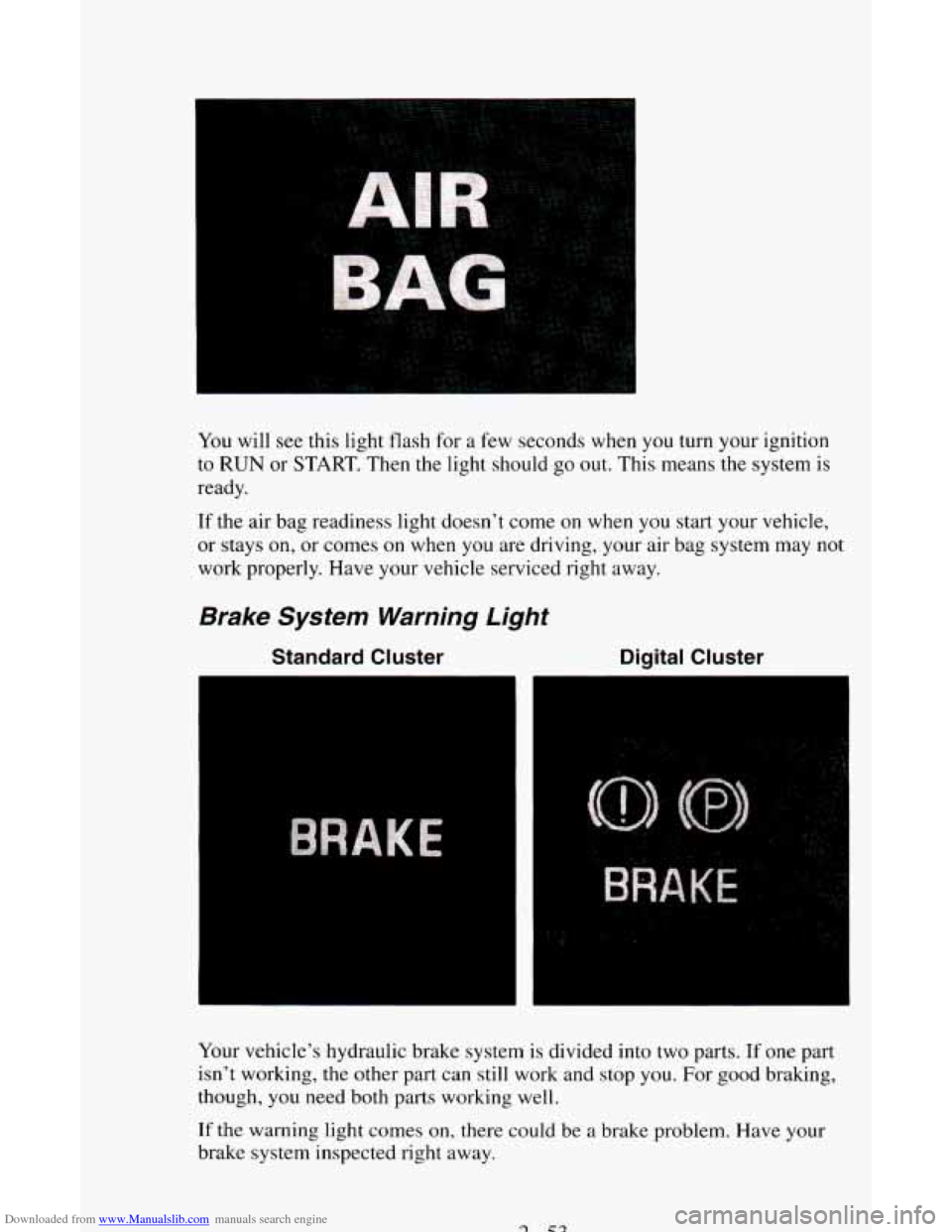
Downloaded from www.Manualslib.com manuals search engine You will see this light flash for a few seconds when you turn your ignition
to
RUN or START. Then the light should go out. This means the system is
ready.
If the air bag readiness light doesn’t come on when you start your vehicle,
or stays on, or comes
on when you are driving, your air bag system may not
work properly. Have your vehicle serviced right away.
Brake System Warning Light
Standard Cluster Digital Cluster
Your vehicle’s hydraulic brake system is divided into two parts. If one part
isn’t working, the other
part can still work and stop you. For good braking,
though, you need both
parts working well.
If the warning light comes on, there could be a brake problem. Have your
brake system inspected right away.
Page 108 of 342
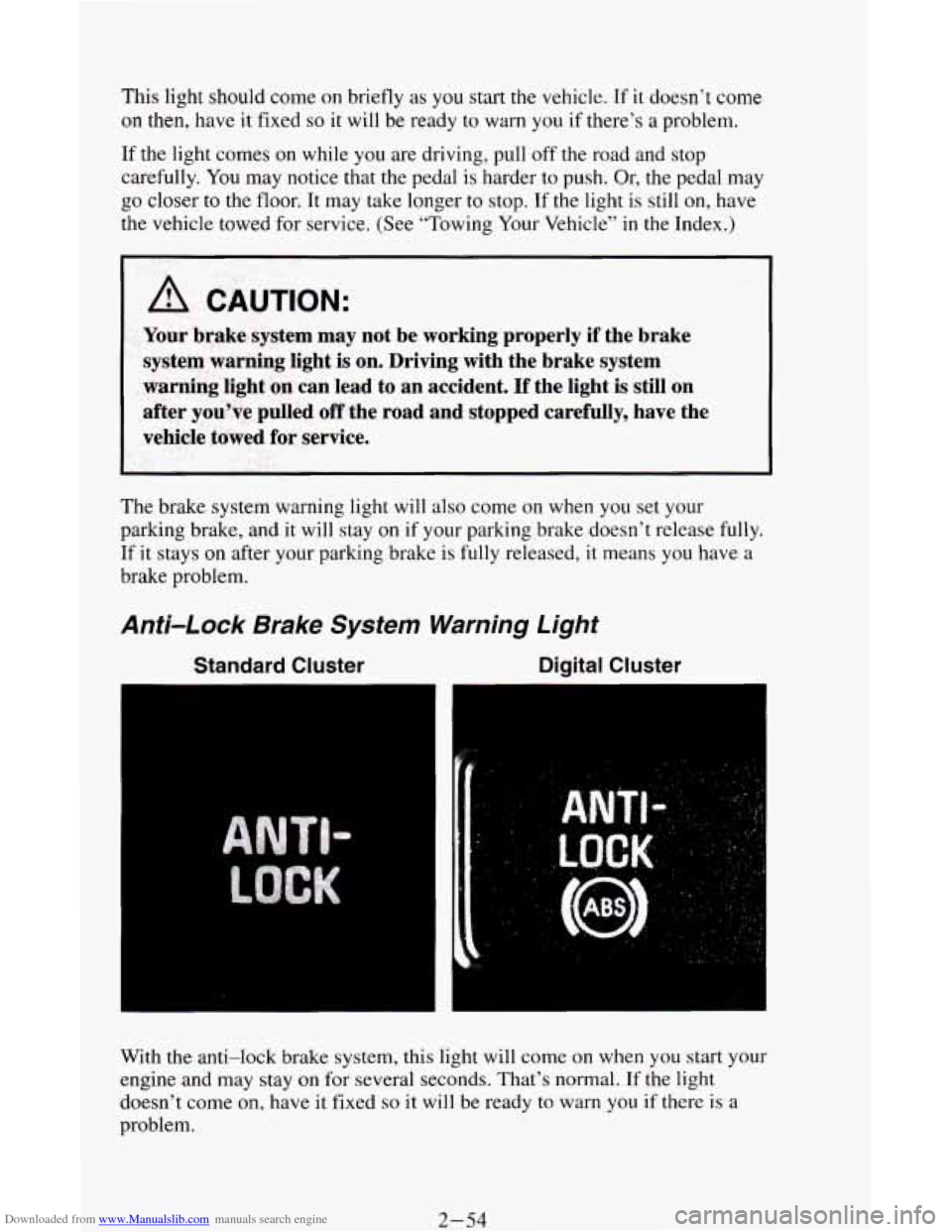
Downloaded from www.Manualslib.com manuals search engine This light should come on briefly as you start the vehicle. If it doesn’t come
on then, have it fixed
so it will be ready to warn you if there’s a problem.
If the light comes on while you are driving, pull off the road and stop
carefully. You may notice that the pedal
is harder to push. Or, the pedal may
go closer
to the floor. It may take longer to stop. If the light is still on, have
the vehicle towed for service. (See “Towing Your Vehicle’’
in the Index.)
b
A CAUTION:
Your brake system may not be working properly if the brake
system warning light is on. Driving with the brake system warning light on can lead to an accident. If the light is st\
ill on
after you’ve pulled off the road and stopped carefully, have\
the
vehicle towed for service.
The brake system warning light will also come on when you set your
parking brake, and it will stay on if your parking brake doesn’t release fully.
If it stays on after your parking brake is fully released, it means you have a
brake problem.
Anti-Lock Brake System Warning Light
Standard Cluster Digital Cluster
With the anti-lock brake system, this light will come on when you start your
engine and may stay on for several seconds. That’s normal. If the light
doesn’t come on, have it fixed
so it will be ready to warn you if there is a
problem.
2-54
Page 109 of 342
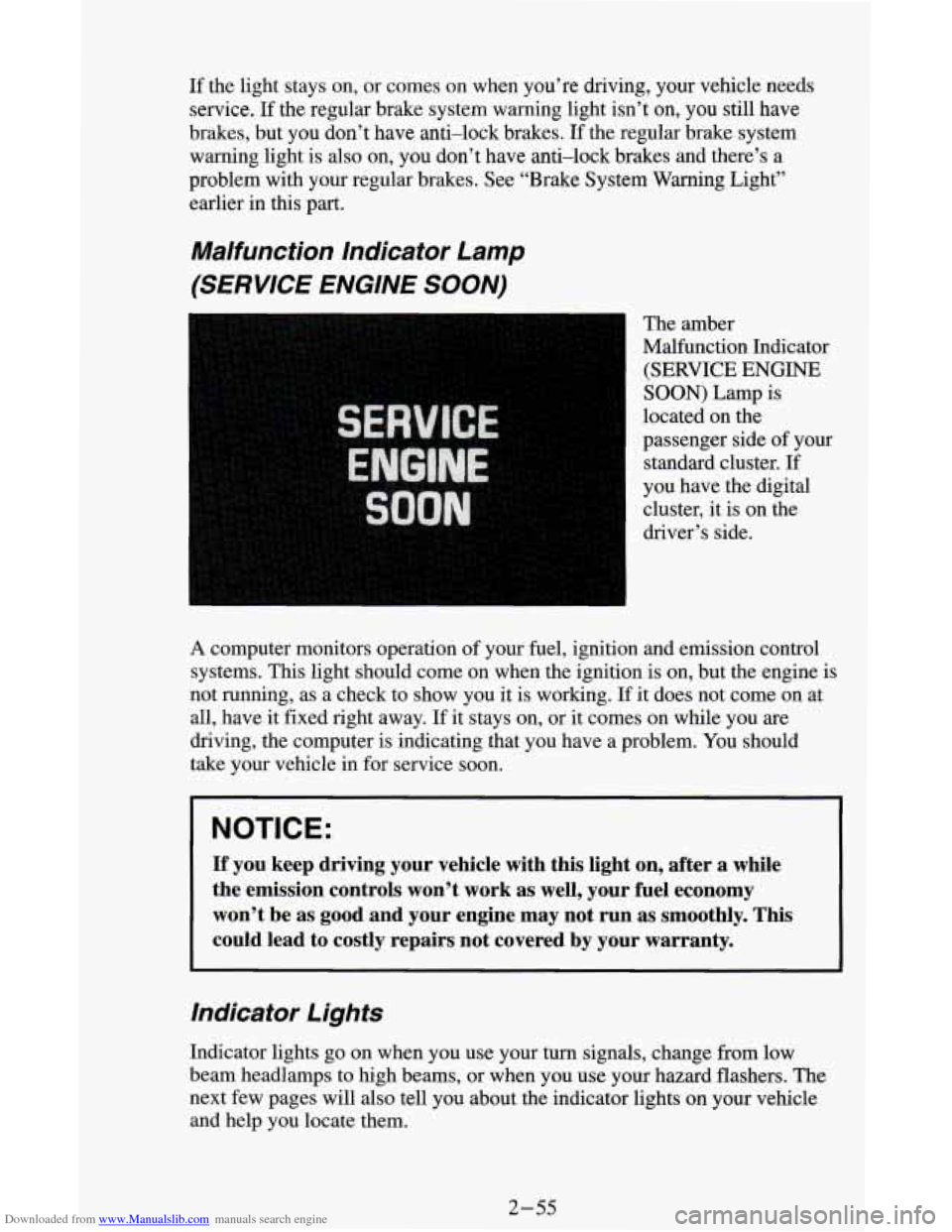
Downloaded from www.Manualslib.com manuals search engine If the light stays on, or comes on when you’re driving, your vehicle needs
service.
If the regular brake system warning light isn’t on, you still have
brakes, but you don’t have anti-lock brakes. If the regular brake system
warning light
is also on, you don’t have anti-lock brakes and there’s a
problem with your regular brakes. See “Brake System Warning Light”
earlier in this part.
Malfunction Indicator Lamp
(SERVICE ENGINE
SOON)
The amber
Malfunction Indicator
(SERVICE
ENGINE
SOON) Lamp is
located on the
passenger side of your
standard cluster. If
you have the digital
cluster, it is
on the
driver’s side.
A computer monitors operation of your fuel, ignition and emission control
systems. This light should come on when the ignition is
on, but the engine is
not running, as a check to show you it is working.
If it does not come on at
all, have it fixed right away.
If it stays on, or it comes on while you are
driving, the computer is indicating that you have a problem. You should
take your vehicle in for service soon.
NOTICE:
If you keep driving your vehicle with this light on, after a whi\
le
the emission controls won’t work as well, your fuel economy \
won’t be as good and your engine may not run as smoothly. \
This
could lead to costly repairs not covered by your warranty.
Indicator Lights
Indicator lights go on when you use your turn signals, change from low
beam headlamps to high beams, or when you use your hazard flashers.
The
next few pages will also tell you about the indicator lights on your vehicle
and help you locate them.
2-55
Page 111 of 342
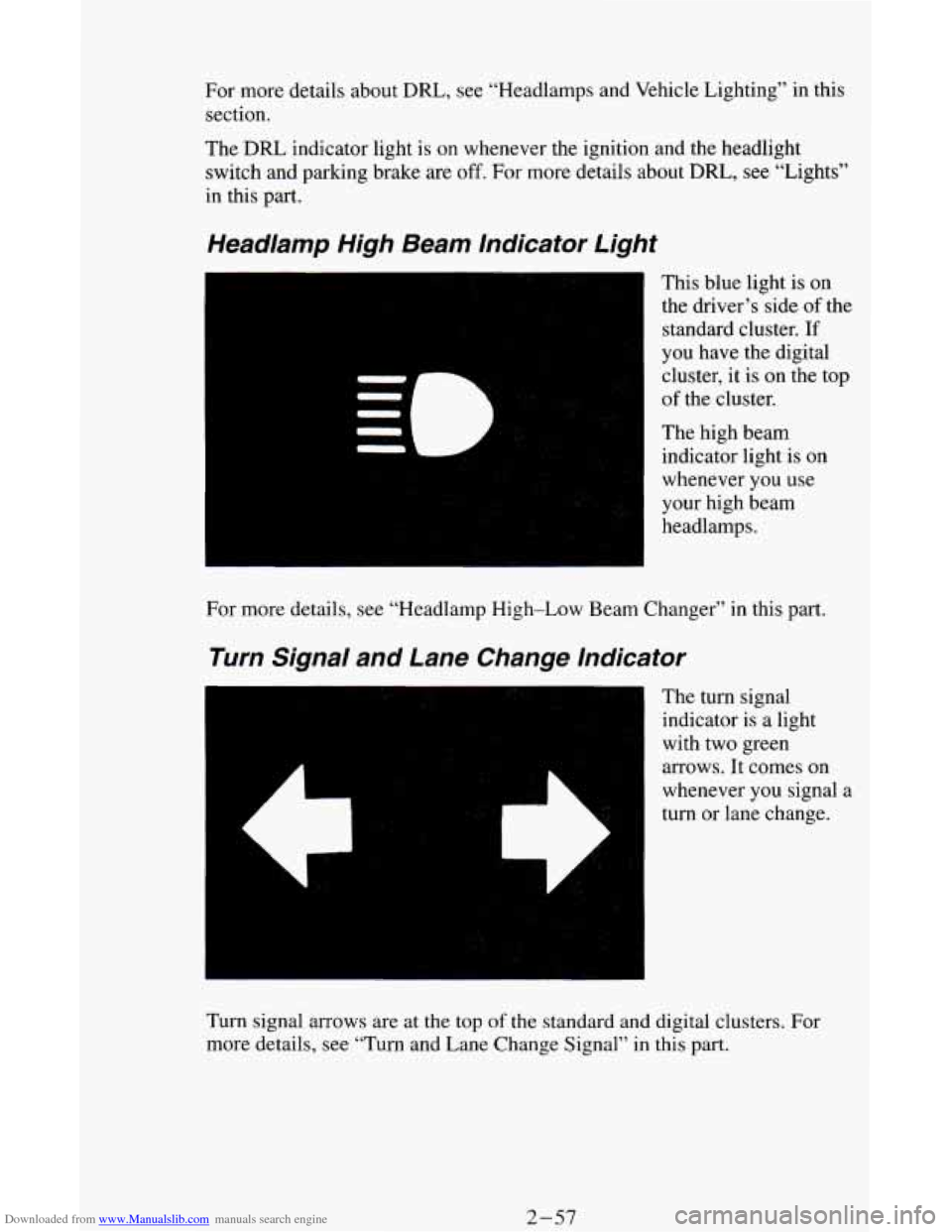
Downloaded from www.Manualslib.com manuals search engine For more details about DRL, see “Headlamps and Vehicle Lighting” in this
section.
The
DRL indicator light is on whenever the ignition and the headlight
switch and parking brake are
off. For more details about DRL, see “Lights”
in this part.
Headlamp High Beam Indicator Light
This blue light is on
the driver’s side
of the
standard cluster.
If
you have the digital
cluster, it
is on the top
of the cluster.
The high beam
indicator light is
on
whenever you use
your high beam
headlamps.
For more details, see “Headlamp High-Low Beam Changer” in this part.
Turn Signal and Lane Change Indicator
The turn signal
indicator is
a light
with two green
arrows. It comes on
whenever you signal
a
turn or lane change.
Turn signal arrows are at the
top of the standard and digital clusters. For
more details, see “Turn and Lane Change Signal”
in this part.
2-57
Page 140 of 342
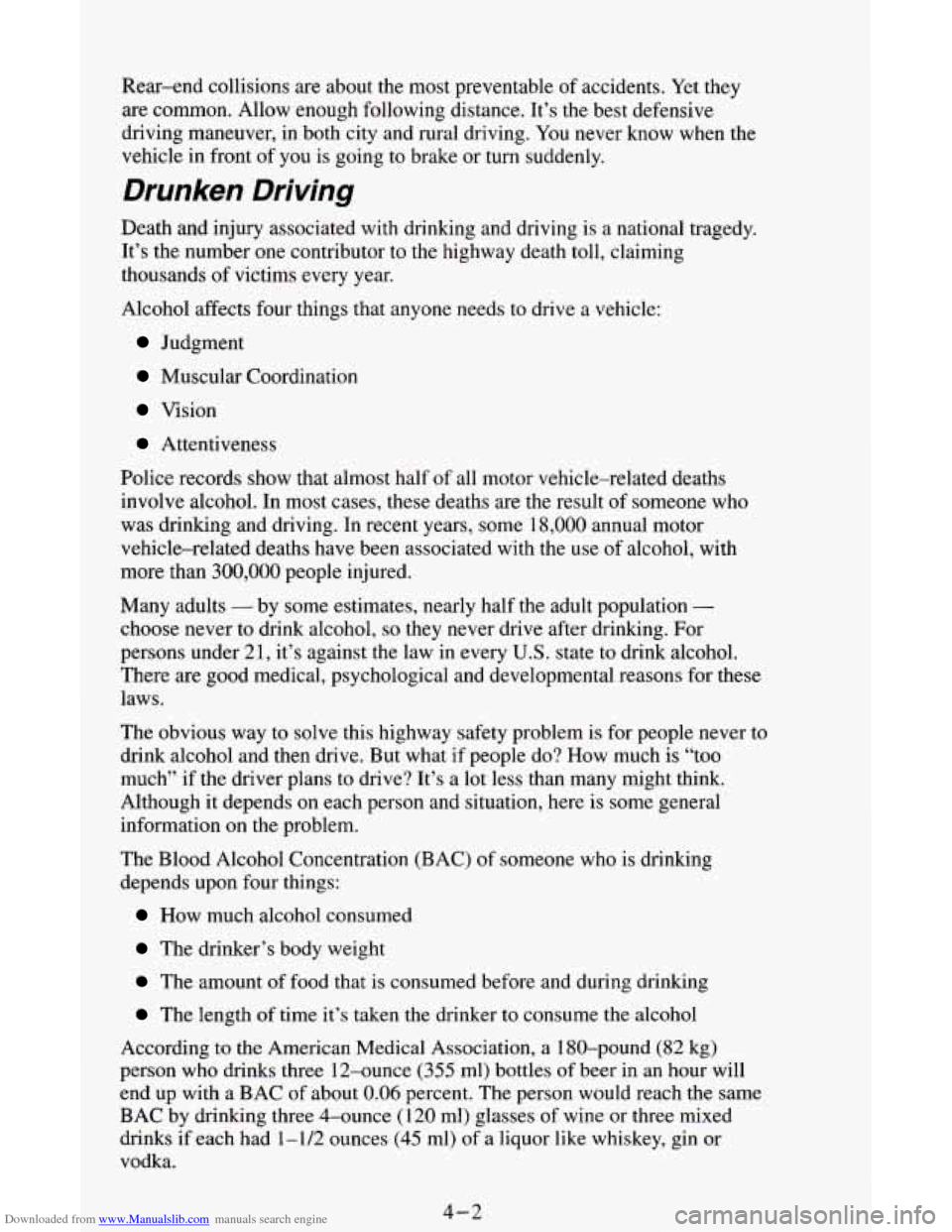
Downloaded from www.Manualslib.com manuals search engine Rear-end collisions are about the most preventable of accidents. Yet they
are common. Allow enough following distance. It’s the best defensive
driving maneuver, in both city and rural driving. You never know when the
vehicle in front of you is going to brake or turn suddenly.
Drunken Driving
Death and injury associated with drinking and driving is a national tragedy.
It’s the number one contributor to the highway death toll, claiming
thousands
of victims every year.
Alcohol affects four things that anyone needs to drive a vehicle:
Judgment
Muscular Coordination
Vision
Attentiveness
Police records show that almost half of all motor vehicle-related deaths
involve alcohol. In most cases, these deaths are the result
of someone who
was drinking and driving. In recent years, some 18,000 annual motor
vehicle-related deaths have been associated with the use of alcohol, with
more than
300,000 people injured.
Many adults
- by some estimates, nearly half the adult population -
choose never to drink alcohol, so they never drive after drinking. For
persons under
21, it’s against the law in every U.S. state to drink alcohol.
There are good medical, psychological and developmental reasons for these
laws.
The obvious way to solve this highway safety problem is for people never to
drink alcohol and then drive. But what if people do? How much is “too
much” if the driver plans to drive? It’s a lot less than many might think.
Although it depends on each person and situation, here is some general
information
on the problem.
The Blood Alcohol Concentration (BAC) of someone who
is drinking
depends upon four things:
How much alcohol consumed
The drinker’s body weight
The amount of food that is consumed before and during drinking
The length of time it’s taken the drinker to consume the alcohol
According
to the American Medical Association, a 180-pound (82 kg)
person who drinks three 12-ounce
(355 ml) bottles of beer in an hour will
end up with a BAC of about
0.06 percent. The person would reach the same
BAC by drinking three 4-ounce
(1 20 ml) glasses of wine or three mixed
drinks if each had
1-1/2 ounces (45 ml) of a liquor like whiskey, gin or
vodka.
4-2